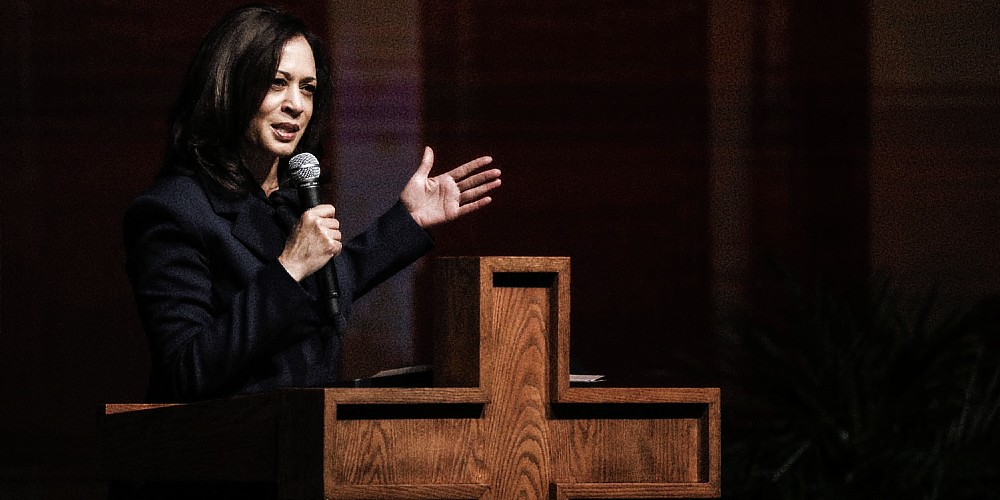(Liberty Nation)—In a presidential campaign marked by one bombshell occurrence after another, it is easy to lose sight of fundamental issues that newly minted Democratic nominee Kamala Harris has yet to address. As the vice president dodges scrutiny in the run-up to the Democratic National Convention, Donald Trump and Republicans have spent plenty of time discussing the areas where the VP is highly vulnerable, primarily the economy and illegal immigration, which together rate as the most serious concerns of a majority of voters. But there has been little talk about an issue of profound importance to tens of millions of Americans on which Harris might be just as exposed: her view of Christianity.
The vice president’s own religious background is telling. Her mother was Indian and Hindu, her father Jamaican and Christian. As Trump has pointed out, she has alternated between identities during her career. During her formative years in Canada and later in the US, she attended both a Black Baptist church and a Hindu temple. Like Barack Obama, Harris’ father is a Marxist academic, which provides crucial context to her record of hostility toward Catholics and evangelical Christians. But whatever influences hit closest to home during her upbringing and throughout her political career, her record on religion is worthy of close scrutiny – and deep concern.
“The vice president has a strong Christian faith that she’s talked about a lot,” Jamal Simmons, Harris’ former communications director, told The Washington Times. But like so many other aspects of her persona, you would be hard-pressed to figure out exactly what that means in light of her record over more than a decade of public service.
The Kamala Harris Brand of Christianity
Harris’ 2019 ranking as the single most liberal senator in the entire nation was not without merit. One year earlier, she had famously ignored Article VI of the US Constitution prohibiting religious tests on judicial appointments during a Senate hearing. She asked a nominee to the federal court, Brian Buescher, if he was aware that the Knights of Columbus (KOC), a widely familiar charitable organization, “opposed a woman’s right to choose” and whether he had “ever, in any way, assisted with or contributed to advocacy against women’s reproductive rights.” Incredibly, Harris’ progressive colleague, Sen. Mazie Hirono (D-HI), went on to ask the nominee if he would resign from the KOC if confirmed.
As California attorney general, Harris backed a 2015 state law requiring pro-life pregnancy crisis centers to offer abortion referrals. The US Supreme Court vacated the law as a violation of free speech. As a longtime supporter of Planned Parenthood, she also authorized a 2015 raid on the home of pro-life activist David Daleiden after he secretly recorded Planned Parenthood affiliates selling fetal tissue from abortions.
Then there was her time in the Senate, when she sponsored a bill, the 2019 “Do No Harm Act,” requiring Catholic hospitals to cover abortions and gender-transition surgeries, despite their objections based on centuries of settled Catholic theology. She infuriated Christians by cosponsoring the 2017 Equality Act to protect the right of biological males who identify as female to enter girls’ and women’s facilities. And as part of her radical agenda during her run for the presidential nomination in 2020, she proposed that states be required to obtain permission from the Justice Department to pass any abortion restrictions.
Like many left-wing Christians, Harris claims that traditional Christian beliefs are perfectly compatible with her own, declaring at a recent NAACP Convention that supporting abortion access “does not require anyone to abandon their faith or their beliefs.” Of course, that flies directly in the face of the teachings of the Catholic Church, even with a Pope in the thrall of progressive theology, which continues to unilaterally oppose abortion.
But perhaps the most revealing insight into the Democratic presidential nominee’s beliefs might come from her statement excising one-third of the most defining statement of American values ever written. Indeed, in 2023, Harris deliberately left out the word “life” in stating during a pro-abortion speech that the Declaration of Independence guaranteed the right to “liberty and the pursuit of happiness.”
Almost 20% of the US population is Catholic. Another 39% identify as “born again” or evangelical, according to Gallup. That adds up to more than half the country. Will Kamala Harris reassure people of faith that she will protect their religious liberty, or will she try to win the election by doubling down on her progressive view of faith?



